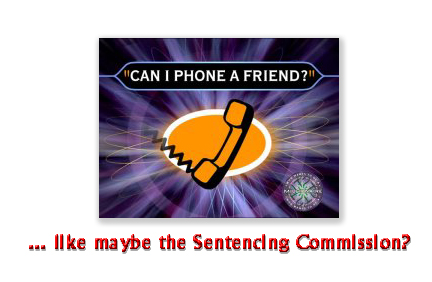We post news and comment on federal criminal justice issues, focused primarily on trial and post-conviction matters, legislative initiatives, and sentencing issues.
PAY THE MAN, SHIRLEY
From New York comes an interesting civil action with a happy ending for a couple of guys who did 18 years on a bum murder rap.
 When a 16-year girl was found raped and murdered back in 1984, Nassau County Police were stumped. After a few months, some mutt shot his mouth off, and the police sweated him until he admitted he’d heard some disjointed but lurid details about the crime from John Restivo. John in turn was sweated by the cops, and he pointed the finger at Dennis Halstead without implicating himself. Nassau County detective Joe Volpe – who may as well have been the real-life model for NYPD Blue detective Andy Sipowicz – then subjected John Kogut, a co-worker of John and Dennis, to an overnight interrogation complete with screaming, threats and beatings.
When a 16-year girl was found raped and murdered back in 1984, Nassau County Police were stumped. After a few months, some mutt shot his mouth off, and the police sweated him until he admitted he’d heard some disjointed but lurid details about the crime from John Restivo. John in turn was sweated by the cops, and he pointed the finger at Dennis Halstead without implicating himself. Nassau County detective Joe Volpe – who may as well have been the real-life model for NYPD Blue detective Andy Sipowicz – then subjected John Kogut, a co-worker of John and Dennis, to an overnight interrogation complete with screaming, threats and beatings.
Unsurprisingly, Kogut confessed (who wouldn’t have?). He implicated John and Dennis in the horrific crime in a statement containing lurid details provided largely by the helpful officers. The police then grabbed John Restivo’s van alleged to have been involved in the crime. They found no blood. However, Det. Volpe recovered some hairs later linked to Theresa.
The Kogut confession could not be used in John’s and Dennis’s trial, because Kogut refused to testify. The jury convicted them anyway, and they went away for 35-to-life.
Fast forward 20 years or so. With much better DNA tests available, the semen sample recovered from the deceased was tested again. Not only were John, Dennis and the weak-kneed Kogut ruled out, but as well a total of 82 friends, acquaintances (and the deceased’s boyfriend) were all excluded as well. In fact, no one in the national DNA database matched the sample from the victim.

All three defendants – John, Dennis and Mr. Kogut – won new trials. The State tried Kogut first, but even his coerced confession wasn’t enough to convict him, with the spectre of an unknown assailant looming in the case. After Kogut was acquitted, the State threw in the towel, and dismissed the case against John and Dennis.
Inmates who fight their cases in post-conviction motions often dream of winning acquittal, and then turning the victory into a big payday because of wrongful conviction. It’s harder than it sounds – statutes that permit recovery usually require that the former prisoner prove his innocence as a condition of payment. Still, Dennis and John were able to collect $2 million from the State of New York, not a lot for 36 combined years of prison.
Then, the two went after Det. Volpe and some other Nassau County police, suing under 42 U.S.C. 1983 and claiming their constitutional rights were violated. They won against the late Detective Volpe, netting an $18 million judgment.
Last week, the 2nd Circuit upheld the judgment.
Det. Volpe was held liable on the strength of two showings. First, a man named French had reported his car was stolen from the roller rink at which the victim worked on the very day of her disappearance. When the car was recovered a week later, investigators found a pair of jeans that matched the distinctive pattern worn by the victim and a piece of nylon rope the man said had been in his back seat when the car was stolen. The police held the jeans and rope, but both disappeared.

The victim had been strangled with a rope, and the car – when it was found about a mile from the roller rink – had phony license tags. Yet Det. Volpe, who conceded at the time that the missing car and items in it were exculpatory evidence that should have been given to the defense under Brady v. Maryland, never told the district attorney about it. The Court of Appeals agreed that the detective’s failure to disclose the evidence – which he admitted was exculpatory – was a willful violation of John’s and Dennis’s constitutional rights. At trial, the plaintiffs’ expert on police procedures
testified that, based on the evidence he had, the French lead was clearly exculpatory, and should have been documented and sent to a prosecutor, based on minimally accepted police practices in the 1980s. In particular, he concluded that based on the time and location of the theft, the fact that the car’s license plates were removed, the fact that a rope was in the back seat at the time of the theft and a rope was used as a ligature to strangle Ms. Fusco, and the fact that a pair of women’s or girls’ striped jeans were found in the back seat of the vehicle, with at least one leg turned inside out, this lead was clearly exculpatory.
Fischer testified that under minimally accepted practices, exculpatory evidence does not need to definitively prove innocence in order for it to have to be documented and disclosed, and that the combination of all of these factors meant that the evidence should have been disclosed under minimally accepted police practices.”
The most troublesome piece of evidence for John and Dennis was the victim’s hair found in the van. The evidence on that clinched matters, the appellate panel implied.

It seems that when a body dies, after a period of 16 hours of so, a condition known as post-mortem root banding occurs, a distinctive series of striations around the root of hair. The coroner had taken hair from the victim’s body and stored it in a locker, a locker to which Det. Volpe had unfettered access. It now turns out that the hair Det. Volpe said had come from the van showed PMRB consistent with the hair taken from the corpse. The evidence, however, showed that it would have been impossible for hair with such PMRB to have been left in the van, because the state’s theory of the case was that she was still alive when in the van.
The Court of Appeals agreed that the evidence was easily sufficient for the civil jury to conclude that there was never any of the victim’s hair in the van, and that Det. Volpe had taken some of the autopsy hair and slipped it into a new envelope, claiming it had come from the van.
The 2nd disposed of a host of other arguments, including that $18 million for two innocent men spending 36 years in prison was too much. The judgment in favor of John and Dennis was upheld.
Restivo v. Volpe, Case No. 14-4662-cv (2nd Cir. Jan. 19, 2017)
– Thomas L. Root



































